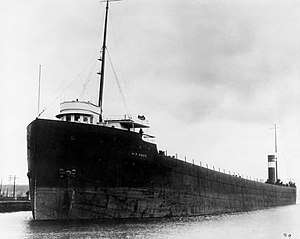SS H.P. Bope
 The H.P. Bope sailing through the Soo Locks in 1909 | |
| History | |
|---|---|
| Name: |
|
| Operator: |
|
| Port of registry: |
|
| Builder: | Superior Shipbuilding Company |
| Yard number: | 519 |
| Launched: | October 19, 1907 |
| In service: | October 1907 |
| Out of service: | June 26, 1978 |
| Identification: | U.S. Registry #204664 |
| Fate: | Scrapped in 1978, in Santander, Spain |
| General characteristics | |
| Class and type: | Lake freighter |
| Tonnage: |
|
| Length: | 560 ft (170 m) |
| Beam: | 56 ft (17 m) |
| Height: | 30 ft (9.1 m) |
| Installed power: | 2x Scotch marine boilers |
| Propulsion: | 2,200 horsepower Quadruple expansion steam engine |
The H.P. Bope was an American steel hulled propeller driven Great Lakes freighter built in 1907 by the Superior Shipbuilding Company of Superior, Wisconsin for service on the Great Lakes of North America. She was used to transport bulk cargoes such as coal, iron ore and grain.
History
The Bope was launched on October 19, 1907 as hull #519. She had a length of 560 feet, a beam of 56 feet and a depth of 30 feet. She was powered by a 2,200 horsepower quadruple expansion steam engine and fueled by two coal-fired Scotch marine boilers.[1]
In 1913 the Bope was transferred to the Lackawanna Steamship Company of Cleveland, Ohio. Later that year the fleet was renamed Interlake Steamship Company. In 1916 the Bope was renamed E.A.S. Clarke. The Clarke anchored off the Great Lakes Engineering Works in the Detroit River on October 26, 1924 because of heavy fog. As she was swinging at anchor the steamer B.F. Jones struck the Clarke near her aft deckhouse causing her to sink almost immediately. No lives were lost in this accident.[2]
In 1952 the Clarke had a new top tank and two new side tanks installed. She also had her cargo hatches rebuilt from 32 cargo hatches on 12-foot centers to 16 hatches on 24-foot centers. In 1953 she had new Foster-Wheeler water tube boilers installed. She went into layup in the winter of 1960. She remained in layup when she was transferred to the Pickands Mather Company.
Kinsman Voyager
In April 1970 the Clarke was sold to the Kinsman Marine Transit Company of Cleveland, Ohio and renamed Kinsman Voyager. On September 30, 1972 the Voyager was departing the Globe elevator in Superior, Wisconsin when she backed into a mud bank and severely damaged her rudder. She was laid up on May 26, 1973 in Toledo, Ohio.[3]
In the Spring of 1974 the Voyager was sold to the Marine Salvage Ltd. of Port Colborne, Ontario. She arrived in Port Colborne on April 22, 1974 towed by the tug Salvage Monarch. She was eventually sold to Lutgens & Reimers of Hamburg, Germany. On May 2, 1975 the Voyager passed Cape Vincent towed by the tugs Salvage Monarch and the Helen M. McAllister bound for Quebec City. The Voyager and another steamer the James E. Ferris departed Quebec on June 7, 1975 towed by the Polish tug Jantar. They arrived in Hamburg on July 4, 1975. The hulls of the Voyager and the Ferris were used as storage hulks. The Voyager arrived in Bilbao, Spain on June 26, 1978. She was later towed to Pasaia, Spain on July 16, 1978. On August 29, 1978 she was towed to Santander, Spain where she was scrapped by Recuperaciones Submarinas S.A..
References
- ↑ "Historical Perspectives-Kinsman Voyager". BoatNerd. Retrieved 25 January 2018.
- ↑ "Bope, H.P." Great Lakes Vessel History. Retrieved 25 January 2018.
- ↑ "Bope, H.P." Bowling State Green University. Retrieved 25 January 2018.